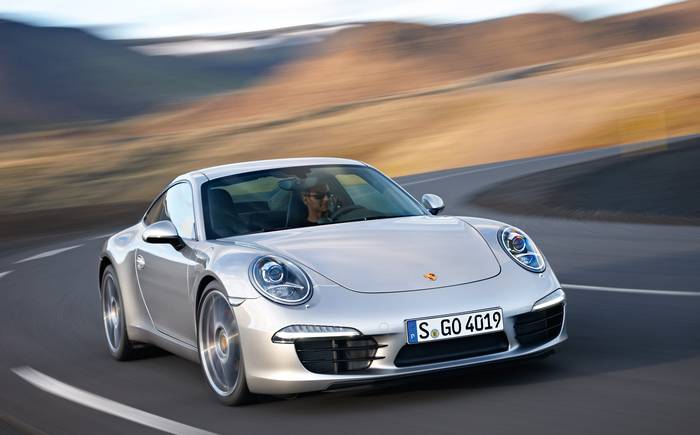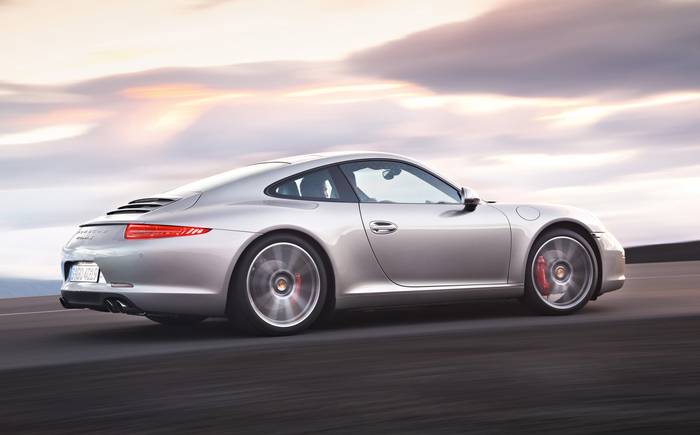First drive review: Porsche 911 Turbo S (2013)
Happy Birthday, 911: You're older, wiser but faster

In Turbo form Porsche’s flagship is still quite able to set your trousers on fire, but subtle hints tel Giles Smith that the car is in control even if he isn’t
A short queue of brand-new Porsche 911 Turbo Ss idles in a pit lane, awaiting the signal to join the circuit. I’m two back in a silver one, affecting nonchalance, although someone appears to be playing Rimsky-Korsakov’s Flight of the Bumblebee on my nervous system. For one thing there’s the car — fitted with a 552bhp engine capable of accelerating from a standing start like a pellet of wet paper off the end of a ruler, and a convincing argument on its own for the virtues of fire-resistant trousers. For another thing there’s the circuit — a spanking new testing facility at Bilster Berg, in northern Germany, although the term “testing” would have to be accounted a casual understatement. During some preliminary laps at caustic speed in the passenger seat beside a qualified racing driver, it has occurred to me that I’ve never come across a circuit quite so comprehensively booby-trapped.
Search for and buy a quality used Porsche 911 on driving.co.uk
To stage an actual race here would be surely to invite immediate and internationally newsworthy carnage. To stage a test of Porsche 911 Turbos by British journalists, perhaps ditto. There are blind corners, blind chicanes, blind switchbacks . . . Even the long straight has a couple of elephantine humps in it — just for a laugh — so that you don’t so much reach the far corner as land on it, with your stomach squeezed up under your collarbone.
Pausing only to light imaginary candles for myself in an imaginary nearby chapel, I exit the pit lane. The next few minutes of my life are mostly about clinging on and hoping. I do the blind corner; the blind chicane. Directly after a blind hairpin bend a short stretch of tarmac rises disconcertingly to a blind brow — beyond which, you eventually discover, is further straight track, though precious little comfort the knowledge will bring you.
Belting up that hill with my teeth clenched, an expensive lump of Porsche’s exquisite engineering howling angrily behind me, and involuntary whimpers escaping from my bloodless lips, I appear to be heading straight for the sky and can only tremblingly imagine that the consequence of leaving the accelerator down will be to arrive shortly afterwards in Holland, probably upside down. But no. When I open my eyes again I am still in Germany and still somehow on the track, albeit now travelling at the kind of speed from which in the real world no good could possibly come beyond my arrest.
Meanwhile, the dashboard is considerately monitoring, among other things, the forces currently ironing my face to the headrest — not that I’m particularly attending to the dashboard. Nevertheless, help is clearly at hand. Beneath both the fear and the engine noise, I am distantly aware of the car pulsing and twitching, quietly steadying and realigning itself and giving every reassuring impression of knowing this ridiculous circuit and its own limits far better than any human. It’s reassuring — kind of. At any rate, by the end of four laps, my shoulders, initially level with the tops of my ears, have descended as far as the lobes.
People have been terrifying themselves in 911 Turbos for nearly 40 years now. First shown as a prototype at the Frankfurt motor show in 1973, 10 years after the launch of the standard 911, the car went on sale the following year and has been making the world go frighteningly blurry since.
So hands up if you were expecting Porsche to mark the Turbo’s ruby anniversary by slowing it down a bit, adding a practical tailgate and issuing a “family” version. I didn’t think so: 911 Turbos only get more powerful — 29bhp more powerful in the case of the new Turbo S’s 3.8-litre flat-six engine. The unit in the marginally less fruity standard Turbo generates 514bhp.
Back in 1974 the launch model had a 3-litre flat-six offering 256bhp, so you see what happens if you give a Porsche 40 years. In the matter of body shape, by contrast, the company has traditionally taken its cue from nature, with its sports models evolving at the same rate as certain fish. Even now, in the age of squinting and angular light clusters, Porsche designers can run up a more than passable impression of the circular headlamp.
The odds are that humankind will grow a third leg before a Porsche radically changes its roofline. Fair enough, too, because you shouldn’t play fast and loose with history. The shape of the 911 Turbo, with its expansive rear wing, rapidly became iconic, to the extent that it’s a real area of debate as to which back end appeared in poster form on more bedroom walls in those early years: the 911 Turbo’s or the one belonging to that underwear-free tennis player.
The fad for turbocharging and all its power-enhancing wonders arguably began formally in 1974 with this car. Since when, through careful upgrades and minimal cosmetic enhancements, the 911 Turbo has importantly endured as the proud flame-thrower in the Porsche range — the trailblazer for feats of tarmac-monstering downforce. Of course, none of this is to suggest that the 911 Turbo was straight away a convenient car to drive.
Tempting though it is to wallow warmly in nostalgia for those first stabs at the form, the oral history of early 911 Turbo use offers a quiet corrective. Survivors of the era will eagerly tell you that original 911 Turbo brakes were largely a no-go area unless you were happy to see that famous back end overtake the less famous front end on the inside. Similarly, the most efficient way to change lane in a 911 Turbo was simply to accelerate.
In some ways the 40-year story of the 911 Turbo could be seen as a progressive attempt to get this unleashed beast under some plausible semblance of control. Thus we now arrive at this latest, electronically tamed incarnation, its amateur-friendly mechanical enhancements including all-wheel drive for smoother power distribution, “active rear-axle steering” that twists the car still more accurately into corners — and, incidentally, blesses it with a sixpence-like turning circle — and “adaptive aerodynamics”, which refers not just to the self-deploying rear wing but also to a front spoiler that automatically scoops forward to gather and suck back the air according to your speed.
The car is fractionally longer and lower than the model it replaces. It benefits from Porsche’s implausibly proactive and freshly reappraised seven-speed automatic gearbox. Its wheels are taller and fatter and its rear section is slightly more swollen. So never mind that you can barely get an overnight bag in the front: at least you can stand a briefcase on the wheelarch.

Yet at the same time this 911 Turbo is more economical. Emissions have been cut and fuel consumption is down by 16% on the previous model. Three cheers for all that, of course, although one looks to a Porsche 911 Turbo for its excellence in the realm of economy, surely, about as sensibly as one turns to Nigel Mansell for a display of expertise in showjumping. Furthermore, this is a car whose simplicity of operation would have been entirely unthinkable in 1974.
Indeed I can report, after not just those anxious test circuits but also a 90-minute burst through some leafy German countryside, that the use of the brakes yields no surprising outcomes and can be wholeheartedly encouraged. In addition the accelerator pulls the car forwards in a straight line without anyone having to use both their chin and their chest to hold the wheel in place.
Why, out on the road, I even found myself driving nonchalantly one-handed — an outcome beyond the wildest dreams of the early adopter with his permanently white-knuckled fists and stiffened spine. Of course, some may find this ease of use contrary to the 911 Turbo’s pioneering spirit and lament the loss of the old ways, with their heartwarming room for error — both human and mechanical. They may have a point.
On the other hand they may merely be masochists. Either way, if you have any unrealised ambitions in the area of 911 Turbo ownership, it’s probably best to climb on board now while your services are still in any way needed. A few more versions on, it’ll be driving itself.
Verdict ★★★★☆
Blast-off made easy.
Factfile
- Engine:
- 3800cc, 6 cylinders, turbo
- Power:
- 552bhp @ 6500rpm
- Torque:
- 516lb ft @ 2100rpm
- Transmission:
- 7-speed dual-clutch automatic
- Acceleration:
- 0-62mph in 3.1sec
- Top speed:
- 197mph
- Fuel:
- 29.1mpg
- CO2:
- 227g/km
- Dimensions:
- L 4506mm, W 1880mm, H 1296mm





